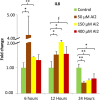Bacterial secretions of nonpathogenic Escherichia coli elicit inflammatory pathways: a closer investigation of interkingdom signaling
- PMID: 25759496
- PMCID: PMC4453519
- DOI: 10.1128/mBio.00025-15
Bacterial secretions of nonpathogenic Escherichia coli elicit inflammatory pathways: a closer investigation of interkingdom signaling
Abstract
There have been many studies on the relationship between nonpathogenic bacteria and human epithelial cells; however, the bidirectional effects of the secretomes (secreted substances in which there is no direct bacterium-cell contact) have yet to be fully investigated. In this study, we use a transwell model to explore the transcriptomic effects of bacterial secretions from two different nonpathogenic Escherichia coli strains on the human colonic cell line HCT-8 using next-generation transcriptome sequencing (RNA-Seq). E. coli BL21 and W3110, while genetically very similar (99.1% homology), exhibit key phenotypic differences, including differences in their production of macromolecular structures (e.g., flagella and lipopolysaccharide) and in their secretion of metabolic byproducts (e.g., acetate) and signaling molecules (e.g., quorum-sensing autoinducer 2 [AI-2]). After analysis of differential epithelial responses to the respective secretomes, this study shows for the first time that a nonpathogenic bacterial secretome activates the NF-κB-mediated cytokine-cytokine receptor pathways while also upregulating negative-feedback components, including the NOD-like signaling pathway. Because of AI-2's relevance as a bacterium-bacterium signaling molecule and the differences in its secretion rates between these strains, we investigated its role in HCT-8 cells. We found that the expression of the inflammatory cytokine interleukin 8 (IL-8) responded to AI-2 with a pattern of rapid upregulation before subsequent downregulation after 24 h. Collectively, these data demonstrate that secreted products from nonpathogenic bacteria stimulate the transcription of immune-related biological pathways, followed by the upregulation of negative-feedback elements that may serve to temper the inflammatory response.
Importance: The symbiotic relationship between the microbiome and the host is important in the maintenance of human health. There is a growing need to further understand the nature of these relationships to aid in the development of homeostatic probiotics and also in the design of novel antimicrobial therapeutics. To our knowledge, this is the first global-transcriptome study of bacteria cocultured with human epithelial cells in a model to determine the transcriptional effects of epithelial cells in which epithelial and bacterial cells are allowed to "communicate" with each other only through diffusible small molecules and proteins. By beginning to demarcate the direct and indirect effects of bacteria on the gastrointestinal (GI) tract, two-way interkingdom communication can potentially be mediated between host and microbe.
Copyright © 2015 Zargar et al.
Figures






References
Publication types
MeSH terms
Substances
LinkOut - more resources
Full Text Sources
